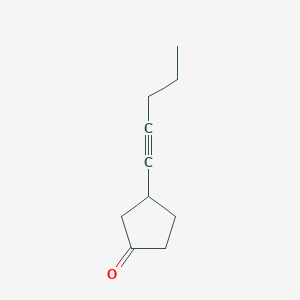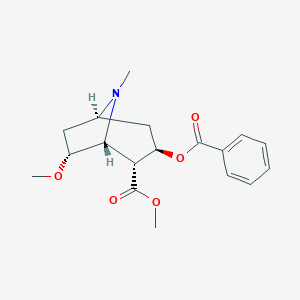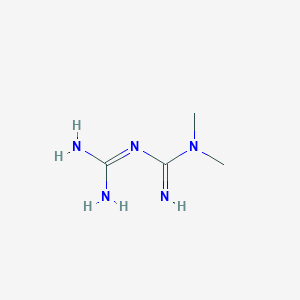
メトホルミン
概要
説明
Metformin is a biguanide antihyperglycemic agent primarily used to manage type 2 diabetes mellitus. It is known for its ability to lower blood glucose levels without causing hypoglycemia. Metformin works by decreasing hepatic glucose production, increasing insulin sensitivity, and enhancing peripheral glucose uptake and utilization .
作用機序
Target of Action
Metformin, a biguanide antihyperglycemic agent, primarily targets the liver and the gastrointestinal tract . It is known to interact with several molecular targets, including PRKAB1, ETFDH, and GPD1L . It also targets the Warburg effect by activating AMPK to downregulate the mTOR pathway .
Mode of Action
Metformin’s interaction with its targets leads to a decrease in insulin resistance and a clinically significant reduction of plasma fasting insulin levels . It inhibits hepatic gluconeogenesis and intestinal absorption of glucose, and improves insulin sensitivity by increasing peripheral glucose uptake and utilization . Metformin’s action is facilitated by the organic cation transporter 1 (OCT 1), which is mostly expressed in the liver .
Biochemical Pathways
Metformin affects numerous cellular targets and pathways to exert its glucose-lowering effects . It activates the AMP-activated protein kinase (AMPK) pathway and modulates mitochondrial metabolism . It also impacts the glycolytic pathway , leading to a reduction in cytosolic dihydroxyacetone phosphate (DHAP) and a rise in the cytosolic NADH–NAD ratio .
Pharmacokinetics
Metformin is absorbed predominately from the small intestine and is rapidly distributed following absorptionThe elimination half-life of Metformin during multiple dosages in patients with good renal function is approximately 5 hours .
Result of Action
The molecular and cellular effects of Metformin’s action include a decrease in hepatic glucose production, an improvement in insulin sensitivity, and an increase in peripheral glucose uptake and utilization . It also has anti-inflammatory effects, suppresses proinflammatory responses, inhibits oxidative stress, and attenuates mTOR-mediated cell hypertrophy .
Action Environment
Environmental factors can influence the action of Metformin. For instance, the presence of NO3− and Cl− in water can promote the photolysis rates of Metformin, while bicarbonate and fulvic acid can inhibit these rates . Additionally, Metformin’s effectiveness and adverse effects can vary based on the digestive system’s impact .
科学的研究の応用
Metformin has a wide range of scientific research applications, including:
Chemistry: Metformin is used as a reagent in various chemical reactions and studies.
Biology: It is studied for its effects on cellular metabolism and insulin signaling pathways.
Medicine: Beyond its primary use in managing type 2 diabetes, metformin is being investigated for its potential benefits in treating polycystic ovary syndrome, cancer, and cardiovascular diseases
Industry: Metformin is used in the pharmaceutical industry for the production of antidiabetic medications.
生化学分析
Biochemical Properties
Metformin interacts with various enzymes and proteins to exert its effects. It has been shown to inhibit hepatic gluconeogenesis, a process that contributes to elevated blood glucose levels in type 2 diabetes . This inhibition is achieved through a redox-dependent mechanism involving the alteration of the cellular redox balance . Metformin also inhibits the mitochondrial glycerol-3-phosphate dehydrogenase, leading to an increased cytosolic redox state .
Cellular Effects
Metformin exerts several effects on cells. It primarily reduces hepatic glucose production and increases insulin sensitivity, thereby lowering both basal and postprandial plasma glucose . It also has effects on muscle and gut microbiota . Furthermore, metformin has been shown to suppress the self-renewal ability of certain resistant cells and reduce the expression of stemness-related markers .
Molecular Mechanism
The molecular mechanism of metformin involves the activation of adenosine monophosphate (AMP)-activated kinase (AMPK) pathway and modulation of mitochondrial metabolism . Metformin’s inhibition of complex I is observed at millimolar concentrations that are not therapeutically relevant . At clinically relevant concentrations, metformin inhibits hepatic gluconeogenesis in a redox-dependent manner .
Temporal Effects in Laboratory Settings
In laboratory settings, metformin shows a selective increase in colonic 18F-FDG uptake after a relatively long period of treatment, and this effect persists soon after drug washout . This suggests that metformin causes a selective increase in colonic glucose metabolism, reflecting a biological response to chronic metformin treatment .
Dosage Effects in Animal Models
In animal models, metformin has shown significant suppression of inflammation and degree of pulmonary fibrosis in the lung tissue . It also reduced the content of hydroxyproline, collagen I, α-SMA, and TGF-β and phosphorylation levels of Smad2, Smad3, p-smad2/3/smad2/3, ERK1/2, and p-ERK1/2/ERK1/2 in lung tissues .
Metabolic Pathways
Metformin is involved in several metabolic pathways. It reduces insulin levels, which can decrease insulin growth factor-1 (IGF-1), thereby inhibiting cancer cell growth . It also affects numerous cellular targets and pathways to exert its glucose-lowering effects as well as other metabolic effects, such as immune modulation, suppression of proinflammatory responses, inhibition of oxidative stress, and attenuation of mTOR-mediated cell hypertrophy .
Transport and Distribution
The distribution of metformin depends on specific organic cation transporter proteins that are organ- and species-specific . The higher concentration of metformin in liver compared with plasma suggests that metformin enters hepatocytes via a specific mechanism, and is distributed mainly within the cytosol .
Subcellular Localization
Metformin is distributed mainly within the cytosol of hepatocytes . This subcellular localization is crucial for its function, as it allows metformin to interact with its intracellular targets and exert its therapeutic effects .
準備方法
Synthetic Routes and Reaction Conditions: Metformin is synthesized through the reaction of dimethylamine hydrochloride with dicyandiamide. The reaction is typically carried out under heating conditions, often using microwave irradiation at temperatures ranging from 100 to 160°C .
Industrial Production Methods: In industrial settings, metformin hydrochloride is produced by heating raw materials such as dicyandiamide and dimethylamine hydrochloride. The reaction is conducted in a controlled environment to ensure high yield and purity of the final product .
化学反応の分析
Types of Reactions: Metformin undergoes various chemical reactions, including:
Oxidation: Metformin can be oxidized under specific conditions, leading to the formation of different oxidation products.
Reduction: Reduction reactions involving metformin are less common but can occur under certain conditions.
Substitution: Metformin can participate in substitution reactions, particularly in the presence of strong nucleophiles.
Common Reagents and Conditions:
Oxidation: Common oxidizing agents include hydrogen peroxide and potassium permanganate.
Reduction: Reducing agents such as sodium borohydride can be used.
Substitution: Strong nucleophiles like sodium hydroxide can facilitate substitution reactions.
Major Products Formed: The major products formed from these reactions depend on the specific conditions and reagents used. For example, oxidation can lead to the formation of various oxidized derivatives of metformin .
類似化合物との比較
Metformin is unique among antihyperglycemic agents due to its multifaceted mechanism of action and minimal risk of hypoglycemia. Similar compounds include:
Phenformin: Another biguanide with similar glucose-lowering effects but higher risk of lactic acidosis.
Buformin: Similar to metformin but less commonly used due to safety concerns.
Sulfonylureas: These stimulate insulin secretion but carry a higher risk of hypoglycemia compared to metformin .
Metformin’s unique combination of efficacy, safety, and additional health benefits makes it a preferred choice for managing type 2 diabetes and exploring new therapeutic applications.
特性
IUPAC Name |
3-(diaminomethylidene)-1,1-dimethylguanidine | |
|---|---|---|
| Source | PubChem | |
| URL | https://pubchem.ncbi.nlm.nih.gov | |
| Description | Data deposited in or computed by PubChem | |
InChI |
InChI=1S/C4H11N5/c1-9(2)4(7)8-3(5)6/h1-2H3,(H5,5,6,7,8) | |
| Source | PubChem | |
| URL | https://pubchem.ncbi.nlm.nih.gov | |
| Description | Data deposited in or computed by PubChem | |
InChI Key |
XZWYZXLIPXDOLR-UHFFFAOYSA-N | |
| Source | PubChem | |
| URL | https://pubchem.ncbi.nlm.nih.gov | |
| Description | Data deposited in or computed by PubChem | |
Canonical SMILES |
CN(C)C(=N)N=C(N)N | |
| Source | PubChem | |
| URL | https://pubchem.ncbi.nlm.nih.gov | |
| Description | Data deposited in or computed by PubChem | |
Molecular Formula |
C4H11N5 | |
| Source | PubChem | |
| URL | https://pubchem.ncbi.nlm.nih.gov | |
| Description | Data deposited in or computed by PubChem | |
DSSTOX Substance ID |
DTXSID2023270 | |
| Record name | Metformin | |
| Source | EPA DSSTox | |
| URL | https://comptox.epa.gov/dashboard/DTXSID2023270 | |
| Description | DSSTox provides a high quality public chemistry resource for supporting improved predictive toxicology. | |
Molecular Weight |
129.16 g/mol | |
| Source | PubChem | |
| URL | https://pubchem.ncbi.nlm.nih.gov | |
| Description | Data deposited in or computed by PubChem | |
Physical Description |
Solid | |
| Record name | 1,1-Dimethylbiguanide | |
| Source | Human Metabolome Database (HMDB) | |
| URL | http://www.hmdb.ca/metabolites/HMDB0001921 | |
| Description | The Human Metabolome Database (HMDB) is a freely available electronic database containing detailed information about small molecule metabolites found in the human body. | |
| Explanation | HMDB is offered to the public as a freely available resource. Use and re-distribution of the data, in whole or in part, for commercial purposes requires explicit permission of the authors and explicit acknowledgment of the source material (HMDB) and the original publication (see the HMDB citing page). We ask that users who download significant portions of the database cite the HMDB paper in any resulting publications. | |
Boiling Point |
224.1ºC at 760 mmHg | |
| Record name | Metformin | |
| Source | DrugBank | |
| URL | https://www.drugbank.ca/drugs/DB00331 | |
| Description | The DrugBank database is a unique bioinformatics and cheminformatics resource that combines detailed drug (i.e. chemical, pharmacological and pharmaceutical) data with comprehensive drug target (i.e. sequence, structure, and pathway) information. | |
| Explanation | Creative Common's Attribution-NonCommercial 4.0 International License (http://creativecommons.org/licenses/by-nc/4.0/legalcode) | |
Solubility |
Freely soluble | |
| Record name | Metformin | |
| Source | DrugBank | |
| URL | https://www.drugbank.ca/drugs/DB00331 | |
| Description | The DrugBank database is a unique bioinformatics and cheminformatics resource that combines detailed drug (i.e. chemical, pharmacological and pharmaceutical) data with comprehensive drug target (i.e. sequence, structure, and pathway) information. | |
| Explanation | Creative Common's Attribution-NonCommercial 4.0 International License (http://creativecommons.org/licenses/by-nc/4.0/legalcode) | |
Mechanism of Action |
Metformin's mechanisms of action are unique from other classes of oral antihyperglycemic drugs. Metformin decreases blood glucose levels by decreasing hepatic glucose production (also called gluconeogenesis), decreasing the intestinal absorption of glucose, and increasing insulin sensitivity by increasing peripheral glucose uptake and utilization. It is well established that metformin inhibits mitochondrial complex I activity, and it has since been generally postulated that its potent antidiabetic effects occur through this mechanism. The above processes lead to a decrease in blood glucose, managing type II diabetes and exerting positive effects on glycemic control. After ingestion, the organic cation transporter-1 (OCT1) is responsible for the uptake of metformin into hepatocytes (liver cells). As this drug is positively charged, it accumulates in cells and in the mitochondria because of the membrane potentials across the plasma membrane as well as the mitochondrial inner membrane. Metformin inhibits mitochondrial complex I, preventing the production of mitochondrial ATP leading to increased cytoplasmic ADP:ATP and AMP:ATP ratios. These changes activate AMP-activated protein kinase (AMPK), an enzyme that plays an important role in the regulation of glucose metabolism. Aside from this mechanism, AMPK can be activated by a lysosomal mechanism involving other activators. Following this process, increases in AMP:ATP ratio also inhibit _fructose-1,6-bisphosphatase_ enzyme, resulting in the inhibition of gluconeogenesis, while also inhibiting _adenylate cyclase_ and decreasing the production of cyclic adenosine monophosphate (cAMP), a derivative of ATP used for cell signaling. Activated AMPK phosphorylates two isoforms of acetyl-CoA carboxylase enzyme, thereby inhibiting fat synthesis and leading to fat oxidation, reducing hepatic lipid stores and increasing liver sensitivity to insulin. In the intestines, metformin increases anaerobic glucose metabolism in enterocytes (intestinal cells), leading to reduced net glucose uptake and increased delivery of lactate to the liver. Recent studies have also implicated the gut as a primary site of action of metformin and suggest that the liver may not be as important for metformin action in patients with type 2 diabetes. Some of the ways metformin may play a role on the intestines is by promoting the metabolism of glucose by increasing glucagon-like peptide I (GLP-1) as well as increasing gut utilization of glucose. In addition to the above pathway, the mechanism of action of metformin may be explained by other ways, and its exact mechanism of action has been under extensive study in recent years., Metformin is widely used to treat hyperglycemia. However, metformin treatment may induce intrahepatic cholestasis and liver injury in a few patients with type II diabetes through an unknown mechanism. Here we show that metformin decreases SIRT1 protein levels in primary hepatocytes and liver. Both metformin-treated wild-type C57 mice and hepatic SIRT1-mutant mice had increased hepatic and serum bile acid levels. However, metformin failed to change systemic bile acid levels in hepatic SIRT1-mutant mice. Molecular mechanism study indicates that SIRT1 directly interacts with and deacetylates Foxa2 to inhibit its transcriptional activity on expression of genes involved in bile acids synthesis and transport. Hepatic SIRT1 mutation elevates Foxa2 acetylation levels, which promotes Foxa2 binding to and activating genes involved in bile acids metabolism, impairing hepatic and systemic bile acid homeostasis. Our data clearly suggest that hepatic SIRT1 mediates metformin effects on systemic bile acid metabolism and modulation of SIRT1 activity in liver may be an attractive approach for treatment of bile acid-related diseases such as cholestasis., Metformin is antihyperglycemic, not hypoglycemic. It does not cause insulin release from the pancreas and does not cause hypoglycemia, even in large doses. Metformin has no significant effects on the secretion of glucagon, cortisol, growth hormone or somatostatin. Metformin reduces glucose levels primarily by decreasing hepatic glucose production and by increasing insulin action in muscle and fat. ... May decrease plasma glucose by reducing the absorption of glucose from the intestine. /Salt not specified/, Metformin potentiates the effect of insulin by mechanisms not fully understood. Metformin does not stimulate pancreatic beta cells to increase secretion of insulin; insulin secretion must be present for metformin to work properly. It is postulated that metformin decreases hepatic glucose production and improves insulin sensitivity by increasing peripheral glucose uptake and utilization. /Salt not specified/, People with Type 2 diabetes mellitus (T2DM) have reduced bone mineral density and an increased risk of fractures due to altered mesenchymal stem cell (MSC) differentiation in the bone marrow. This leads to a shift in the balance of differentiation away from bone formation (osteogenesis) in favour of fat cell development (adipogenesis). The commonly used anti-diabetic drug, metformin, activates the osteogenic transcription factor Runt-related transcription factor 2 (Runx2), which may suppress adipogenesis, leading to improved bone health. Here we investigate the involvement of the metabolic enzyme, AMP-activated protein kinase (AMPK), in these protective actions of metformin. The anti-adipogenic actions of metformin were observed in multipotent C3H10T1/2 MSCs, in which metformin exerted reciprocal control over the activities of Runx2 and the adipogenic transcription factor, PPARgamma, leading to suppression of adipogenesis. These effects appeared to be independent of AMPK activation but rather through the suppression of the mTOR/p70S6K signalling pathway. Basal AMPK and mTOR/p70S6K activity did appear to be required for adipogenesis, as demonstrated by the use of the AMPK inhibitor, compound C. This observation was further supported by using AMPK knockout mouse embryo fibroblasts (MEFs) where adipogenesis, as assessed by reduced lipid accumulation and expression of the adipogeneic transcription factor, C/EBPbeta, was found to display an absolute requirement for AMPK. Further activation of AMPK in wild type MEFS, with either metformin or the AMPK-specific activator, A769662, was also associated with suppression of adipogenesis. It appears, therefore, that basal AMPK activity is required for adipogenesis and that metformin can inhibit adipogenesis through AMPK-dependent or -independent mechanisms, depending on the cellular context. | |
| Record name | Metformin | |
| Source | DrugBank | |
| URL | https://www.drugbank.ca/drugs/DB00331 | |
| Description | The DrugBank database is a unique bioinformatics and cheminformatics resource that combines detailed drug (i.e. chemical, pharmacological and pharmaceutical) data with comprehensive drug target (i.e. sequence, structure, and pathway) information. | |
| Explanation | Creative Common's Attribution-NonCommercial 4.0 International License (http://creativecommons.org/licenses/by-nc/4.0/legalcode) | |
| Record name | METFORMIN | |
| Source | Hazardous Substances Data Bank (HSDB) | |
| URL | https://pubchem.ncbi.nlm.nih.gov/source/hsdb/7080 | |
| Description | The Hazardous Substances Data Bank (HSDB) is a toxicology database that focuses on the toxicology of potentially hazardous chemicals. It provides information on human exposure, industrial hygiene, emergency handling procedures, environmental fate, regulatory requirements, nanomaterials, and related areas. The information in HSDB has been assessed by a Scientific Review Panel. | |
CAS No. |
657-24-9, 1115-70-4 | |
| Record name | Metformin | |
| Source | CAS Common Chemistry | |
| URL | https://commonchemistry.cas.org/detail?cas_rn=657-24-9 | |
| Description | CAS Common Chemistry is an open community resource for accessing chemical information. Nearly 500,000 chemical substances from CAS REGISTRY cover areas of community interest, including common and frequently regulated chemicals, and those relevant to high school and undergraduate chemistry classes. This chemical information, curated by our expert scientists, is provided in alignment with our mission as a division of the American Chemical Society. | |
| Explanation | The data from CAS Common Chemistry is provided under a CC-BY-NC 4.0 license, unless otherwise stated. | |
| Record name | Metformin [USAN:INN:BAN] | |
| Source | ChemIDplus | |
| URL | https://pubchem.ncbi.nlm.nih.gov/substance/?source=chemidplus&sourceid=0000657249 | |
| Description | ChemIDplus is a free, web search system that provides access to the structure and nomenclature authority files used for the identification of chemical substances cited in National Library of Medicine (NLM) databases, including the TOXNET system. | |
| Record name | Metformin | |
| Source | DrugBank | |
| URL | https://www.drugbank.ca/drugs/DB00331 | |
| Description | The DrugBank database is a unique bioinformatics and cheminformatics resource that combines detailed drug (i.e. chemical, pharmacological and pharmaceutical) data with comprehensive drug target (i.e. sequence, structure, and pathway) information. | |
| Explanation | Creative Common's Attribution-NonCommercial 4.0 International License (http://creativecommons.org/licenses/by-nc/4.0/legalcode) | |
| Record name | Metformin | |
| Source | EPA DSSTox | |
| URL | https://comptox.epa.gov/dashboard/DTXSID2023270 | |
| Description | DSSTox provides a high quality public chemistry resource for supporting improved predictive toxicology. | |
| Record name | Metformin | |
| Source | European Chemicals Agency (ECHA) | |
| URL | https://echa.europa.eu/substance-information/-/substanceinfo/100.010.472 | |
| Description | The European Chemicals Agency (ECHA) is an agency of the European Union which is the driving force among regulatory authorities in implementing the EU's groundbreaking chemicals legislation for the benefit of human health and the environment as well as for innovation and competitiveness. | |
| Explanation | Use of the information, documents and data from the ECHA website is subject to the terms and conditions of this Legal Notice, and subject to other binding limitations provided for under applicable law, the information, documents and data made available on the ECHA website may be reproduced, distributed and/or used, totally or in part, for non-commercial purposes provided that ECHA is acknowledged as the source: "Source: European Chemicals Agency, http://echa.europa.eu/". Such acknowledgement must be included in each copy of the material. ECHA permits and encourages organisations and individuals to create links to the ECHA website under the following cumulative conditions: Links can only be made to webpages that provide a link to the Legal Notice page. | |
| Record name | METFORMIN | |
| Source | FDA Global Substance Registration System (GSRS) | |
| URL | https://gsrs.ncats.nih.gov/ginas/app/beta/substances/9100L32L2N | |
| Description | The FDA Global Substance Registration System (GSRS) enables the efficient and accurate exchange of information on what substances are in regulated products. Instead of relying on names, which vary across regulatory domains, countries, and regions, the GSRS knowledge base makes it possible for substances to be defined by standardized, scientific descriptions. | |
| Explanation | Unless otherwise noted, the contents of the FDA website (www.fda.gov), both text and graphics, are not copyrighted. They are in the public domain and may be republished, reprinted and otherwise used freely by anyone without the need to obtain permission from FDA. Credit to the U.S. Food and Drug Administration as the source is appreciated but not required. | |
| Record name | METFORMIN | |
| Source | Hazardous Substances Data Bank (HSDB) | |
| URL | https://pubchem.ncbi.nlm.nih.gov/source/hsdb/7080 | |
| Description | The Hazardous Substances Data Bank (HSDB) is a toxicology database that focuses on the toxicology of potentially hazardous chemicals. It provides information on human exposure, industrial hygiene, emergency handling procedures, environmental fate, regulatory requirements, nanomaterials, and related areas. The information in HSDB has been assessed by a Scientific Review Panel. | |
| Record name | 1,1-Dimethylbiguanide | |
| Source | Human Metabolome Database (HMDB) | |
| URL | http://www.hmdb.ca/metabolites/HMDB0001921 | |
| Description | The Human Metabolome Database (HMDB) is a freely available electronic database containing detailed information about small molecule metabolites found in the human body. | |
| Explanation | HMDB is offered to the public as a freely available resource. Use and re-distribution of the data, in whole or in part, for commercial purposes requires explicit permission of the authors and explicit acknowledgment of the source material (HMDB) and the original publication (see the HMDB citing page). We ask that users who download significant portions of the database cite the HMDB paper in any resulting publications. | |
Melting Point |
223-226 °C, 223 - 226 °C | |
| Record name | Metformin | |
| Source | DrugBank | |
| URL | https://www.drugbank.ca/drugs/DB00331 | |
| Description | The DrugBank database is a unique bioinformatics and cheminformatics resource that combines detailed drug (i.e. chemical, pharmacological and pharmaceutical) data with comprehensive drug target (i.e. sequence, structure, and pathway) information. | |
| Explanation | Creative Common's Attribution-NonCommercial 4.0 International License (http://creativecommons.org/licenses/by-nc/4.0/legalcode) | |
| Record name | 1,1-Dimethylbiguanide | |
| Source | Human Metabolome Database (HMDB) | |
| URL | http://www.hmdb.ca/metabolites/HMDB0001921 | |
| Description | The Human Metabolome Database (HMDB) is a freely available electronic database containing detailed information about small molecule metabolites found in the human body. | |
| Explanation | HMDB is offered to the public as a freely available resource. Use and re-distribution of the data, in whole or in part, for commercial purposes requires explicit permission of the authors and explicit acknowledgment of the source material (HMDB) and the original publication (see the HMDB citing page). We ask that users who download significant portions of the database cite the HMDB paper in any resulting publications. | |
Retrosynthesis Analysis
AI-Powered Synthesis Planning: Our tool employs the Template_relevance Pistachio, Template_relevance Bkms_metabolic, Template_relevance Pistachio_ringbreaker, Template_relevance Reaxys, Template_relevance Reaxys_biocatalysis model, leveraging a vast database of chemical reactions to predict feasible synthetic routes.
One-Step Synthesis Focus: Specifically designed for one-step synthesis, it provides concise and direct routes for your target compounds, streamlining the synthesis process.
Accurate Predictions: Utilizing the extensive PISTACHIO, BKMS_METABOLIC, PISTACHIO_RINGBREAKER, REAXYS, REAXYS_BIOCATALYSIS database, our tool offers high-accuracy predictions, reflecting the latest in chemical research and data.
Strategy Settings
| Precursor scoring | Relevance Heuristic |
|---|---|
| Min. plausibility | 0.01 |
| Model | Template_relevance |
| Template Set | Pistachio/Bkms_metabolic/Pistachio_ringbreaker/Reaxys/Reaxys_biocatalysis |
| Top-N result to add to graph | 6 |
Feasible Synthetic Routes
Q1: What is the primary mechanism of action of metformin in lowering blood glucose levels?
A: Metformin primarily lowers blood glucose levels by decreasing hepatic glucose production (HGP). [] It achieves this by inhibiting the glucagon-induced HGP through the suppression of the protein kinase A (PKA) → Forkhead box protein O1 (Foxo1) signaling pathway. []
Q2: Does metformin directly interfere with transforming growth factor beta 2 (TGF-β2) signaling in glioblastoma cells?
A: While metformin has shown inhibitory effects on glioblastoma cell proliferation and migration, research suggests that it does not directly interfere with TGF-β2 signaling. [] Both metformin and TGF-β2 seem to independently inhibit proliferation and/or migration in these cells. []
Q3: How does nutrient availability affect metformin's ability to induce apoptosis in breast cancer cells?
A: Research suggests that metformin induces apoptosis more effectively in breast cancer cells grown in nutrient-poor conditions, compared to cells cultured in high glucose/high amino acid media. [] This effect is linked to AMP-activated protein kinase (AMPK) activation and downregulation of pyruvate kinase M2 (PKM2) expression. []
Q4: What is the molecular formula and weight of metformin?
A4: Metformin's molecular formula is C4H11N5 and its molecular weight is 129.16 g/mol.
Q5: How do structural modifications of metformin impact its activity?
A: While the provided research doesn't delve into specific structural modifications of metformin, it does highlight the importance of its chemical structure for its diverse effects. For example, its biguanide structure is crucial for its ability to interact with cellular targets and elicit metabolic changes. [] Further research exploring specific structural modifications and their impact on metformin's activity would be valuable.
Q6: Are there different formulations of metformin available, and how do they differ in their effects?
A: Yes, metformin is available in both immediate-release (IR) and extended-release (XR) formulations. [] Studies suggest that metformin XR may provide better glycemic control, improve lipid profiles, and positively influence adipocytokine levels compared to the IR formulation. []
Q7: How does discontinuation of metformin affect bowel activity, as measured by FDG uptake in PET/CT scans?
A: Research indicates that discontinuing metformin for 48 hours prior to a PET/CT scan results in lower FDG accumulation in the bowel compared to no discontinuation or 24-hour discontinuation. []
Q8: How is metformin excreted from the body?
A: Metformin is primarily excreted unchanged by the kidneys. [] This is important to note, as its excretion can be affected in individuals with impaired renal function, potentially leading to metformin accumulation and increased risk of lactic acidosis. []
Q9: What is the effect of metformin on Li-Fraumeni Syndrome (LFS) in preclinical models?
A: Preclinical studies using mouse models of LFS have shown that metformin can significantly prolong survival. [] This effect was observed when metformin treatment was initiated both early and late in the lifespan of these mouse models. []
Q10: Does metformin affect cancer stem cell populations in colorectal cancer?
A: Research suggests that metformin treatment can decrease the CD133+ cancer stem cell population in colorectal cancer cell lines. [] The exact mechanisms by which metformin achieves this effect require further investigation. []
Q11: How does metformin affect glucose homeostasis in bovine mammary epithelial cells (PBMECs) challenged with lipoteichoic acid (LTA)?
A: Research suggests that metformin can attenuate the inflammatory and oxidative stress responses induced by LTA in PBMECs. [] This protective effect is mediated through the AMPK/Nrf2/NF-κB signaling pathway. []
Q12: Can metformin improve vascular function in insulin-resistant rats?
A: Studies show that metformin can improve vascular function in insulin-resistant rats, independent of its effects on metabolic parameters. [] This improvement is attributed to metformin's ability to enhance acetylcholine-induced relaxation in blood vessels, likely through a direct mechanism involving nitric oxide. []
Q13: Does metformin have any impact on the incidence of type 2 diabetes mellitus (T2DM) and cardiovascular disease risk factors in overweight and obese individuals?
A: Research suggests that metformin, in conjunction with lifestyle modifications and management of cardiovascular risk factors, can reduce the incidence of T2DM in overweight and obese individuals. [] Metformin use was also associated with improvements in various cardiovascular risk factors, including a reduction in total cholesterol and LDL-C levels. []
Q14: Can metformin be used to manage hyperglycemia in severely burned patients?
A: A Phase II clinical trial indicated that metformin can effectively control blood glucose levels in severely burned patients, comparable to insulin therapy. [] Importantly, metformin was associated with a significantly lower incidence of hypoglycemia compared to insulin. []
Q15: How does metformin compare to other non-insulin glucose-lowering drugs in terms of mortality risk in individuals with type 2 diabetes?
A: A network meta-analysis of observational trials suggested that compared to metformin, sulfonylurea drugs increased all-cause mortality risk. [] In contrast, the combination of dipeptidyl peptidase-4 inhibitors (DPP-4i) and metformin showed a consistent risk reduction for both all-cause and cardiovascular mortality compared to other treatments. []
Q16: Are there any known mechanisms of resistance to metformin's anticancer effects?
A: While the provided research does not delve into specific metformin resistance mechanisms in cancer cells, it does highlight that its efficacy can be influenced by factors such as nutrient availability. [] Additionally, the complex interplay between metformin's various cellular targets suggests that resistance mechanisms could involve alterations in these pathways. Further research is needed to fully elucidate metformin resistance mechanisms and develop strategies to overcome them.
Q17: What are the common side effects associated with metformin?
A: The most common side effects of metformin are gastrointestinal symptoms like diarrhea, nausea, and stomach upset. [, ] These side effects are usually mild, transient, and often diminish with continued use or by taking the medication with food. []
Q18: What analytical methods are used to determine the concentration of metformin in pharmaceutical formulations?
A: Studies utilized ultraviolet (UV) spectrophotometry to analyze the content of metformin hydrochloride in both generic and brand name tablets. [] This method allows for accurate quantification of the drug and ensures it meets the required standards.
Q19: What are some alternatives to metformin for the treatment of type 2 diabetes?
A19: Alternatives to metformin for type 2 diabetes management include:
- Sulfonylureas (e.g., glibenclamide, glimepiride): These drugs stimulate insulin secretion from the pancreas. [, , ]
- Dipeptidyl peptidase-4 inhibitors (DPP-4i) (e.g., sitagliptin): These drugs increase incretin levels, which in turn enhance insulin secretion and suppress glucagon release. [, ]
- Glucagon-like peptide-1 receptor agonists (GLP-1 RAs): Similar to DPP-4i, these medications also work through the incretin system. []
Q20: Are there potential advantages of using repaglinide/metformin fixed-dose combination (FDC) compared to other FDCs like rosiglitazone/metformin in type 2 diabetes management?
A: Research suggests that repaglinide/metformin FDC, while similar in efficacy to rosiglitazone/metformin FDC in controlling blood glucose, may offer additional benefits such as a positive impact on lipid profiles. []
Q21: When was metformin reintroduced for the treatment of type 2 diabetes?
A: Metformin was reintroduced for type 2 diabetes treatment in 1995, after being temporarily withdrawn due to concerns about lactic acidosis. []
Q22: What are some of the diverse applications of metformin being investigated beyond its use in diabetes?
A22: Metformin's potential extends beyond diabetes treatment. Research is exploring its use in various fields, including:
- Oncology: Metformin is being investigated as a potential anti-cancer agent in various cancers, including breast, colorectal, and ovarian cancer. [, , , , , ]
- Cardiology: Metformin's potential cardioprotective effects are being studied, particularly its impact on cardiovascular risk factors and its potential role in managing heart failure. [, ]
- Wound Healing: Research is examining metformin's potential to improve wound healing in burn patients, possibly due to its anti-inflammatory and insulin-sensitizing effects. []
試験管内研究製品の免責事項と情報
BenchChemで提示されるすべての記事および製品情報は、情報提供を目的としています。BenchChemで購入可能な製品は、生体外研究のために特別に設計されています。生体外研究は、ラテン語の "in glass" に由来し、生物体の外で行われる実験を指します。これらの製品は医薬品または薬として分類されておらず、FDAから任何の医療状態、病気、または疾患の予防、治療、または治癒のために承認されていません。これらの製品を人間または動物に体内に導入する形態は、法律により厳格に禁止されています。これらのガイドラインに従うことは、研究と実験において法的および倫理的な基準の遵守を確実にするために重要です。


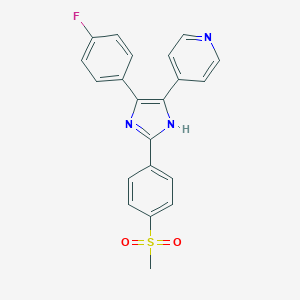

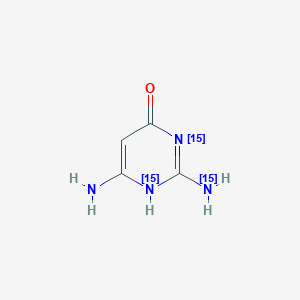
![Imidazo[1,5-a]pyridine-8-carbaldehyde](/img/structure/B114505.png)
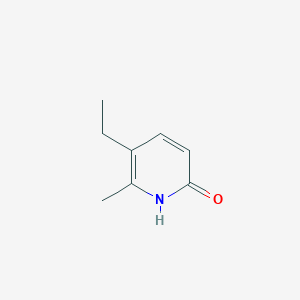
![N-[2-(4-Hydroxyphenylsulfanyl)ethyl]propionamide](/img/structure/B114517.png)
![7-(Acetyloxy)-4-hydroxy-N,N,N-trimethyl-10-oxo-3,5,9-trioxa-4-phosphadodecane-1-aminium]](/img/structure/B114518.png)
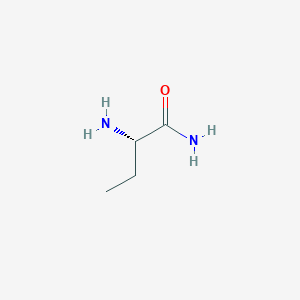
![4-[4-(3,4-Dihydroxyphenyl)pyrrolidin-3-yl]benzene-1,2-diol](/img/structure/B114527.png)
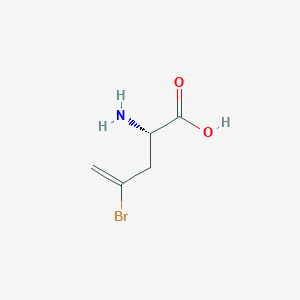
![Methyl 3-oxo-2-azabicyclo[2.2.0]hex-5-ene-6-carboxylate](/img/structure/B114529.png)
![4-Methoxy-benzo[b]thiophene-2-carboxylic acid methyl ester](/img/structure/B114530.png)
